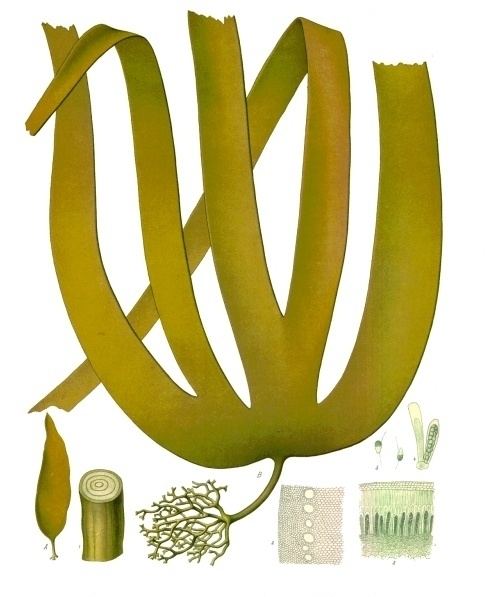Superphylum Heterokonta Order Laminariales | Class Phaeophyceae Family Laminariaceae | |
 | ||
Genus LaminariaJ. V. Lamouroux | ||
Laminaria is a genus of 31 species of brown algae commonly called "kelp". Some species are also referred to as tangle. This economically important genus is characterized by long, leathery laminae and relatively large size. Some species are referred to by the common name Devil's apron, due to their shape, or sea colander, due to the perforations present on the lamina. It is found in the north Atlantic Ocean and the northern Pacific Ocean at depths from 8 to 30 m (26 to 98 ft) (exceptionally to 120 m (390 ft) in the warmer waters of the Mediterranean Sea and off Brazil).
Contents
According to C.Michael Hogan the life cycle of the genus involves a diploid generational system.
Laminaria japonica (J. E. Areschoug – Japón) is now regarded as a synonym of Saccharina japonica and Laminaria saccharina is now classified as Saccharina latissima.
Medical
A laminaria stick may be used to slowly dilate the cervix to induce labor and delivery, or for surgical procedures including abortions or to facilitate the placement of an Intrauterine Device.
Used for Heartburn and Indigestion relief under the brandname phycodol
Food
Various species of Laminaria have been used for food purposes since ancient times wherever humans have encountered them. Typically, the prepared parts, usually the blade, are consumed either immediately after boiling in broth or water, or consumed after drying, or drying then rehydrating. The greater proportion of commercial cultivation is for algin, iodine, and mannitol, which are used in a range of industrial applications. In South Korea it is processed into a sweetmeat known as laminaria jelly, in other countries it is also used in fresh salad form, which is also canned for preservation to deliverу and selling purposes in other regions. Many countries produce and consume laminaria products, but the largest is China.
